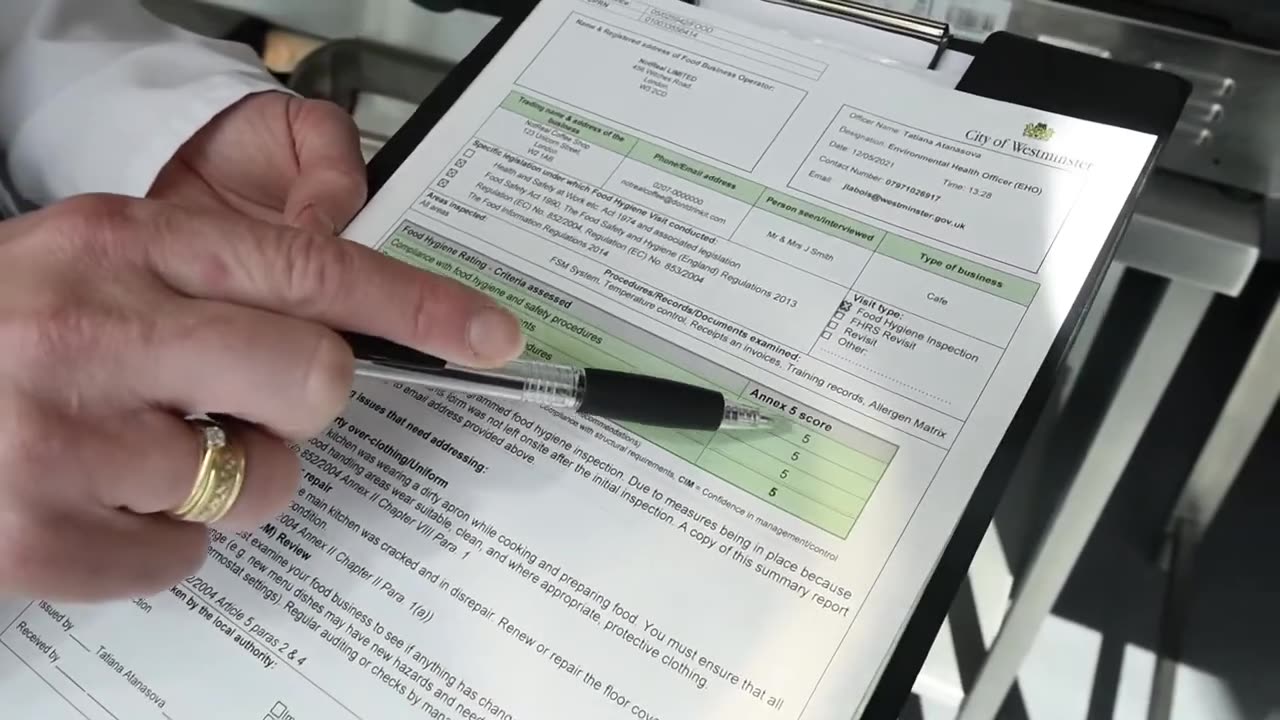Premium Only Content

Food safety - food hygiene inspections_3
**Food Safety - Food Hygiene Inspections**
Food hygiene inspections are essential evaluations conducted to ensure food businesses adhere to food safety standards. These inspections aim to protect public health, prevent foodborne illnesses, and maintain trust in food establishments.
---
### 1. **Objectives of Food Hygiene Inspections**
- **Ensuring Food Safety:** Protecting customers from contamination or unsafe practices.
- **Legal Compliance:** Verifying adherence to local and national food safety regulations.
- **Encouraging Best Practices:** Promoting a culture of cleanliness and responsibility in food businesses.
---
### 2. **Types of Inspections**
- **Routine Inspections:** Scheduled based on risk assessment (e.g., high-risk businesses like restaurants are inspected more often).
- **Unannounced Visits:** Inspectors may visit without prior notice to observe daily operations.
- **Follow-Up Inspections:** Conducted to ensure compliance after initial infractions.
- **Complaint Investigations:** Triggered by customer complaints or reports of illness linked to the business.
---
### 3. **Inspection Focus Areas**
Inspectors assess several key areas during an inspection:
#### a. **Food Preparation and Storage**
- Proper handling of raw and cooked foods to avoid cross-contamination.
- Safe storage practices, including temperature control for perishable items.
- Date marking and stock rotation to prevent use of expired ingredients.
#### b. **Cleanliness and Hygiene**
- Cleanliness of food preparation areas, equipment, and utensils.
- Regular cleaning schedules and use of appropriate cleaning agents.
#### c. **Staff Hygiene Practices**
- Personal hygiene of employees, such as handwashing and use of protective clothing.
- Health monitoring and illness reporting policies for staff.
#### d. **Pest Control Measures**
- Evidence of pest infestations (e.g., rodents, insects).
- Adequate waste disposal and prevention measures to keep pests out.
#### e. **Temperature Management**
- Correct temperatures for cold storage (below 5°C) and hot holding (above 63°C).
- Adequate cooking and reheating procedures to eliminate harmful bacteria.
#### f. **Food Safety Management Systems**
- Implementation of HACCP (Hazard Analysis and Critical Control Points).
- Documentation of monitoring processes, including temperature logs and cleaning records.
---
### 4. **Inspector Findings and Outcomes**
After the inspection, the inspector will provide feedback in a report, which may include:
- **Pass:** The business meets all required standards.
- **Improvement Required:** Minor issues that need corrective action within a specified timeframe.
- **Prohibition/Closure:** Severe breaches of hygiene laws that require immediate action, including potential closure.
In some regions, hygiene ratings (e.g., 0-5 stars) are assigned and may be displayed publicly.
---
### 5. **How to Prepare for an Inspection**
- **Maintain Daily Standards:** Ensure cleanliness, proper storage, and adherence to food safety guidelines at all times.
- **Train Staff:** Regularly educate employees on hygiene practices and legal requirements.
- **Document Procedures:** Keep records of cleaning schedules, temperature checks, and pest control measures.
- **Conduct Internal Audits:** Regularly review operations to identify and correct potential issues before inspections.
---
### 6. **Common Issues Found During Inspections**
- Unsanitary food preparation areas.
- Inadequate handwashing or poor personal hygiene.
- Improper food storage leading to cross-contamination.
- Lack of temperature control for chilled or cooked food.
- Pest infestations or lack of pest control measures.
---
### 7. **Consequences of Non-Compliance**
- **Legal Penalties:** Fines, closure orders, or prosecution.
- **Loss of Reputation:** Negative public perception and customer loss.
- **Health Risks:** Potential outbreaks of foodborne illnesses.
---
**Conclusion**
Food hygiene inspections are vital for maintaining safe food practices and consumer trust. By following food safety regulations and maintaining high hygiene standards, food businesses can ensure compliance, protect public health, and sustain their reputation.
Would you like to focus on any specific inspection area or tips to improve compliance?
-
 6:54
6:54
HSESafetyInformation
6 months ago6 Must Try Breakfast recipes By Food Fusion
351 -
 1:32:53
1:32:53
Flyover Conservatives
9 hours agoRicky Schroder Exposes How Hollywood Planted Him as a Child Star | FOC Show
31.3K7 -
 LIVE
LIVE
JahBlessCreates
4 hours ago🎉 TEKKEN TING, and maybe some music...
320 watching -
 LIVE
LIVE
GritsGG
5 hours agoTop 250 Ranked Grind! Dubulars!🫡
48 watching -
 LIVE
LIVE
StuffCentral
4 hours agoStar Stuffy
10 watching -
 6:02
6:02
Blackstone Griddles
6 hours agoPrime Rib Brisket Burgers on the Blackstone Griddle
9.38K2 -
 3:35:06
3:35:06
HELMETFIRE
3 hours ago🟢HELMETFIRE PLAYS: Silksong Part 4🟢
2.74K -
 1:14:07
1:14:07
Glenn Greenwald
10 hours agoGlenn Takes Your Questions: Billionaires, Bari Weiss and Journalism | SYSTEM UPDATE #509
69.5K35 -
 DVR
DVR
StevieTLIVE
4 hours agoFriday Night HYPE Warzone Games with Stevie
15.2K2 -
 4:11:15
4:11:15
SavageJayGatsby
1 day agoLet's Play: Sea of Thieves | Friend Friday
19.3K2